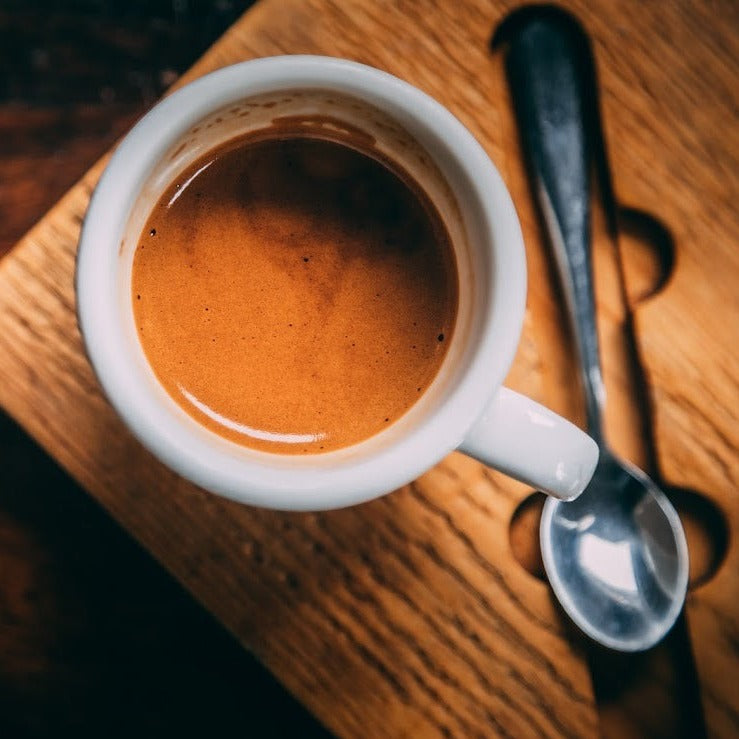Discover the Rich Flavor Profile of SOE Single Origin Espresso Today
Discover the Rich Flavor Profile of SOE Single Origin Espresso Today
Blog Article
Coffee Beans 101: Everything You Need to Find Out About Espresso and Blended Coffee Beans
When it pertains to coffee, comprehending the nuances of coffee and blended beans can transform your day-to-day mug. You'll find the unique features of Arabica and Robusta beans, and just how each effects taste and caffeine content. From the expanding process to roasting strategies, every step contributes in your coffee experience. What makes the ideal brew? Allow's check out the vital components that add to an exceptional cup of coffee.
Recognizing Coffee Beans: Ranges and types
When diving into the globe of coffee, recognizing the kinds and selections of coffee beans is important for every enthusiast. Arabica beans are known for their smooth, complicated flavors and lower caffeine content, making them a favorite amongst coffee enthusiasts.
Within these species, you'll find various regional selections, each bringing special features. For instance, Ethiopian Yirgacheffe uses brilliant floral notes, while Colombian beans give a well-balanced flavor account. As you explore, remember to pay attention to processing approaches like washed or natural, as they can substantially influence the final preference. By familiarizing yourself with these beans and their flavors, you'll raise your coffee experience and make more informed selections in your developing journey.
The Growing Process: From Seed to Bean
When you check out the trip of coffee, all of it starts with seed selection techniques that establish the structure for high quality. From there, farming and gathering play vital roles in guaranteeing the beans grow. Ultimately, processing approaches change those harvested cherries right into the coffee beans you enjoy.
Seed Choice Methods
Choosing the ideal seeds is crucial for generating high-grade coffee beans, as it lays the foundation for the whole growing procedure. You should begin by picking seeds from credible sources that focus on top quality and hereditary diversity. Try to find selections understood to prosper in your specific climate and soil conditions. Pay attention to the seed's age and storage space problems, as fresh seeds tend to germinate much better. When feasible, select natural seeds to decrease exposure to hazardous chemicals. Take into consideration the condition resistance of different varieties, as this can greatly influence your yield. Lastly, do not be reluctant to talk to regional farmers or specialists to gain understandings into the ideal seed alternatives for your region. This understanding will certainly enhance your coffee-growing experience.
Farming and Harvesting
As you support your coffee seeds right into growing plants, understanding the farming and harvesting process is essential for attaining the ideal flavor and quality. Begin by growing your seeds in well-draining soil, ideally in a shaded area to secure them from straight sunshine.
Hand-picking is usually the ideal approach to ensure just the ripest cherries are picked. Timing is crucial; harvesting as well early or too late can influence the flavor profile of your beans.

Processing Approaches Described
When you have actually harvested your coffee cherries, the next crucial action is refining them to change those dynamic fruits into the beans you'll brew. There are 2 major approaches: the completely dry procedure and the wet process. In the completely dry procedure, you spread out the cherries out in the sunlight to dry, allowing the fruit to ferment and give distinct tastes to the beans. On the other hand, the wet process entails removing the fruit quickly and fermenting the beans in water, leading to a cleaner taste. After processing, the beans are hulled, sorted, and normally dried out once again. Each approach influences the taste account, so trying out with both can assist you uncover your favored mixture. Comprehending these methods is key to enjoying your coffee experience.
Toasting Strategies: How Taste Is Established
When it concerns toasting coffee beans, recognizing roast degrees is essential to disclosing their distinct flavors. Each roasting strategy influences the aroma and boosts the taste growth procedure, offering you a richer coffee experience. Let's explore how these variables come with each other to raise your everyday mixture.
Roast Levels Explained
Roast levels play an important duty in shaping the flavor account of your coffee. By comprehending these levels, you can better select a coffee that matches your taste choices. Experiment with various roasts to uncover which one reverberates with you, improving your total coffee experience and enjoyment.
Influence on Scent
The roast degree not just influences the taste of your coffee yet additionally significantly influences its scent. Each roasting technique launches different volatile compounds, shaping exactly how your coffee scents. In addition, the freshness of the beans plays a vital role; fresh baked coffee releases extra aromatic oils, enhancing that attracting aroma.
Taste Growth Refine
As you discover the taste growth procedure, you'll discover that roasting strategies play a vital duty in forming the preference account of your coffee. The roasting temperature and time directly affect the level of acidity, sweet taste, and resentment of the beans. Light roasts preserve more of the bean's initial tastes, highlighting fruity and flower notes. Tool roasts balance acidity and body, providing a well-shaped taste. Dark roasts, on the other hand, draw out strong, great smoky qualities while reducing the bean's integral top qualities. Throughout roasting, chain reactions, like the Maillard response and caramelization, change the beans and enhance their intricacy. Exploring with various roasting levels can assist you locate your excellent brew, so do not think twice to taste and uncover the rich range of tastes!
Coffee vs. Blended Coffee: Key Distinctions
Espresso and blended coffee each offer one-of-a-kind experiences that cater to different preferences and choices. Espresso is a concentrated coffee brewed by requiring warm water with finely-ground coffee beans, leading to an abundant, vibrant taste and a creamy layer of crema on top. It's commonly taken pleasure in as a shot or utilized as a base for beverages like cappuccinos and cappucinos.
On the other hand, blended coffee integrates numerous beans from different areas, developing an extra well balanced taste profile. You'll frequently find blends that highlight body, acidity, or sweet taste, making them flexible for different developing techniques. While SOE espresso focuses on intensity, combined coffee might offer a broader series of tastes that can alter with each sip.
Eventually, your choice in between coffee and blended coffee come down to your personal choice. Whether you hunger for a leisurely mug or a quick jolt, both alternatives have something tasty to supply.

Brewing Approaches: Unlocking the Perfect Cup
When it comes to brewing coffee, discovering the right method can change your experience and elevate your cup. Each brewing technique has its one-of-a-kind appeal and can substantially affect your coffee's taste and aroma. Using a French press permits you to appreciate a rich and full-bodied mixture, while a pour-over technique provides a tidy, intense cup with unique flavors.
If you like coffee, buying a quality maker can assist you master the art of pulling shots. Alternatively, for comfort, a single-serve vessel system offers speed without compromising preference.
Do not fail to remember about cold brew, which provides a smooth, much less acidic coffee suitable for warm days. Experiment with different approaches to find what reverberates with your taste buds.
Sampling Notes: Determining Flavor Profiles
Just how can you absolutely appreciate your coffee if you do not recognize what flavors to seek? Sampling notes are your overview to understanding the complicated globe of coffee. Pay interest to the initial tastes that hit your taste when you drink. You may detect fruity notes, like berry or citrus, or possibly a nutty touch. As you remain to taste, see exactly how the tastes progress-- this is recognized as the "coating." Some coffees could leave a chocolatey or caramel aftertaste, while others might have a bright, tidy surface.
Think about the body of the coffee, as well; is it light and airy or thick and syrupy? Do not forget acidity; an intense level of acidity can include vitality, while a reduced acidity might give a smoother experience. By identifying these flavor profiles, you'll grow your connection with each cup, making coffee tasting a fascinating journey of discovery.

Tips for Selecting and Storage Coffee Beans
Storing and selecting coffee beans effectively can considerably enhance your brewing experience. Beginning by choosing top quality beans that match your taste - SOE.
When you have your beans, keep them in an airtight container to avoid exposure to light, air, and dampness. A dark, amazing location functions best, so avoid maintaining them in the fridge or freezer, as this can present dampness. Just grind the amount you require to preserve freshness; entire beans preserve taste longer than pre-ground coffee.
Lastly, try to use your beans within 2 to 4 weeks after opening for peak preference. Following these suggestions will assure your coffee remains satisfying and delicious, boosting your everyday brew to new heights.
Regularly Asked Concerns
For How Long Do Coffee Beans Keep Fresh After Toasting?
Coffee beans stay fresh for about two weeks after toasting - SOE. You must save them in an airtight container, away from light and dampness. Afterwards, their flavor and scent start to diminish considerably

Can I Mix Different Coffee Bean Varieties?
Absolutely, you can mix different coffee bean varieties! Trying out blends can boost flavors and create a special preference profile. Just ensure to stabilize the strengths and qualities of each variety for the very best outcomes.
What Is the Perfect Work Size for Coffee?
For coffee, you'll desire a great work size, concerning the appearance of common salt. This permits optimal removal, resulting in a rich, tasty shot. Experiment a little bit to discover what suits your preference best!
How Does Elevation Affect Coffee Bean Taste?
Elevation affects coffee bean taste by influencing the development price and chemical composition. Higher elevations bring about slower maturation, which improves level of acidity and intricacy, giving your coffee a vivid and one-of-a-kind preference you will not fail to remember.
Are There Decaffeinated Variations of Espresso Beans?
Yes, there are decaffeinated variations of coffee beans. You can enjoy an abundant espresso taste without the high levels of caffeine kick. Just seek "decaf" blends at your local coffeehouse or specialty shop.
Coffee Beans 101: Everything You Need to Know Regarding Espresso and Blended Coffee Beans.
When diving right into the globe of coffee, recognizing the types and varieties of coffee beans is vital for every enthusiast.When it comes to roasting coffee beans, understanding roast degrees is essential to disclosing their one-of-a-kind tastes. Coffee is a focused coffee brewed by forcing hot water through finely-ground coffee beans, resulting in an abundant, vibrant taste and a creamy layer of crema on top.On the various other hand, mixed coffee incorporates different beans from different areas, creating a much more balanced flavor profile.
Report this page